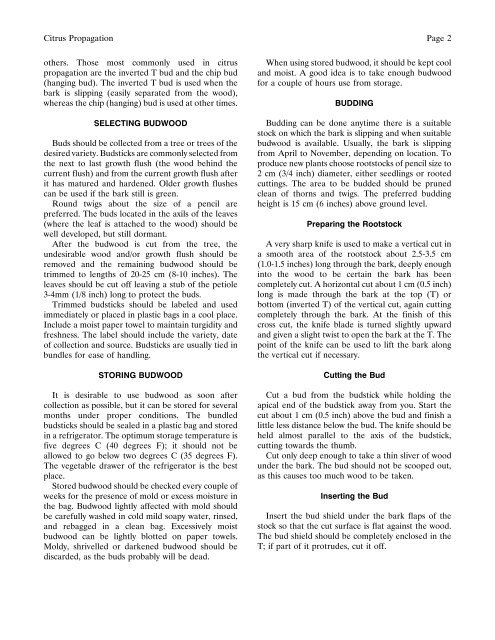Citrus Propagation For Homeowners1
Citrus Propagation For Homeowners1
Citrus Propagation For Homeowners1
Create successful ePaper yourself
Turn your PDF publications into a flip-book with our unique Google optimized e-Paper software.
<strong>Citrus</strong> <strong>Propagation</strong> Page 2<br />
others. Those most commonly used in citrus<br />
propagation are the inverted T bud and the chip bud<br />
(hanging bud). The inverted T bud is used when the<br />
bark is slipping (easily separated from the wood),<br />
whereas the chip (hanging) bud is used at other times.<br />
SELECTING BUDWOOD<br />
Buds should be collected from a tree or trees of the<br />
desired variety. Budsticks are commonly selected from<br />
the next to last growth flush (the wood behind the<br />
current flush) and from the current growth flush after<br />
it has matured and hardened. Older growth flushes<br />
can be used if the bark still is green.<br />
Round twigs about the size of a pencil are<br />
preferred. The buds located in the axils of the leaves<br />
(where the leaf is attached to the wood) should be<br />
well developed, but still dormant.<br />
After the budwood is cut from the tree, the<br />
undesirable wood and/or growth flush should be<br />
removed and the remaining budwood should be<br />
trimmed to lengths of 20-25 cm (8-10 inches). The<br />
leaves should be cut off leaving a stub of the petiole<br />
3-4mm (1/8 inch) long to protect the buds.<br />
Trimmed budsticks should be labeled and used<br />
immediately or placed in plastic bags in a cool place.<br />
Include a moist paper towel to maintain turgidity and<br />
freshness. The label should include the variety, date<br />
of collection and source. Budsticks are usually tied in<br />
bundles for ease of handling.<br />
STORING BUDWOOD<br />
It is desirable to use budwood as soon after<br />
collection as possible, but it can be stored for several<br />
months under proper conditions. The bundled<br />
budsticks should be sealed in a plastic bag and stored<br />
in a refrigerator. The optimum storage temperature is<br />
five degrees C (40 degrees F); it should not be<br />
allowed to go below two degrees C (35 degrees F).<br />
The vegetable drawer of the refrigerator is the best<br />
place.<br />
Stored budwood should be checked every couple of<br />
weeks for the presence of mold or excess moisture in<br />
the bag. Budwood lightly affected with mold should<br />
be carefully washed in cold mild soapy water, rinsed,<br />
and rebagged in a clean bag. Excessively moist<br />
budwood can be lightly blotted on paper towels.<br />
Moldy, shrivelled or darkened budwood should be<br />
discarded, as the buds probably will be dead.<br />
When using stored budwood, it should be kept cool<br />
and moist. A good idea is to take enough budwood<br />
for a couple of hours use from storage.<br />
BUDDING<br />
Budding can be done anytime there is a suitable<br />
stock on which the bark is slipping and when suitable<br />
budwood is available. Usually, the bark is slipping<br />
from April to November, depending on location. To<br />
produce new plants choose rootstocks of pencil size to<br />
2 cm (3/4 inch) diameter, either seedlings or rooted<br />
cuttings. The area to be budded should be pruned<br />
clean of thorns and twigs. The preferred budding<br />
height is 15 cm (6 inches) above ground level.<br />
Preparing the Rootstock<br />
A very sharp knife is used to make a vertical cut in<br />
a smooth area of the rootstock about 2.5-3.5 cm<br />
(1.0-1.5 inches) long through the bark, deeply enough<br />
into the wood to be certain the bark has been<br />
completely cut. A horizontal cut about 1 cm (0.5 inch)<br />
long is made through the bark at the top (T) or<br />
bottom (inverted T) of the vertical cut, again cutting<br />
completely through the bark. At the finish of this<br />
cross cut, the knife blade is turned slightly upward<br />
and given a slight twist to open the bark at the T. The<br />
point of the knife can be used to lift the bark along<br />
the vertical cut if necessary.<br />
Cutting the Bud<br />
Cut a bud from the budstick while holding the<br />
apical end of the budstick away from you. Start the<br />
cut about 1 cm (0.5 inch) above the bud and finish a<br />
little less distance below the bud. The knife should be<br />
held almost parallel to the axis of the budstick,<br />
cutting towards the thumb.<br />
Cut only deep enough to take a thin sliver of wood<br />
under the bark. The bud should not be scooped out,<br />
as this causes too much wood to be taken.<br />
Inserting the Bud<br />
Insert the bud shield under the bark flaps of the<br />
stock so that the cut surface is flat against the wood.<br />
The bud shield should be completely enclosed in the<br />
T; if part of it protrudes, cut it off.
















